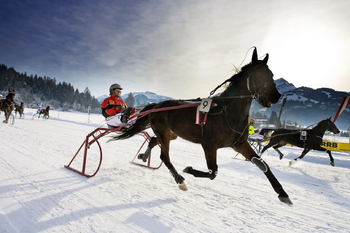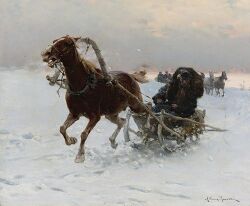Noivage
Noivage is an equestrian sledding race played over snow and ice in sleds or sleighs or, in extreme variants, on skates and skis. It is one of the traditional winter sports of the Aventine countries of Amathia, Etruria, Gaullica and Paretia. It is a popular form of horse racing in colder climates outside of the region as well, notably in Cassier.
The game originates with a courier service that crossed the Transaventines, where rugged terrain, harsh winters, deep snow, and frozen rivers necessitated horse-drawn sleds and sleighs with skilled drivers to deliver foods and basic goods to towns and homesteads.
It has been played at the Winter Invictus Games since 1984, after being introduced as a demonstration sport at the 1980 Winter Invictus Games.
History
Noivage begun not as a sport but as a necessity in the lives of the communities in southern Gaullica, who lived along the Aventines mountain range. Historic communities in the region, going well into Solarian times, were usually isolated and cut off from villages both within and without the mountain range. Horse-sledding developed as a form of easy, accessible, if not precarious, transportation in the region that facilitated the delivering of news, the exchanging and trading of goods and the delivery of important relief should it be required. The utility of such a means of transportation was noted by other communities in the region; and there is scholarly debate on whether the form of transportation occurred independently or of its effectivess spread it around the region.
The village of Seyssel in the Transaventines lays claim to the founding of the sport, with an annual race dating back to the 13th century by the name of noivage in which racers would compete in a lap of the surrounding communities along the Lac-du-Voglans. Historians speculate that this event was not only a race, but keen training for the actual art of delivering to these places. The name is taken from the old Gaullican word noif, meaning snow.
In the 1730s, the race gained aristocratic attention at the petit palais, where the vacationing noblemen and women participated in activities during winter and spring months. The tale goes that a stable boy in the employ of the royal house was born to the south, and had handled the horses who would be used for the deliveries. Others point to the Val de Mareine's terrain - which although not mountainous is hilly and filled with valleys - as being another place the sledding form was well suited to. Regardless of the origin of its arrival to the petit palais, sled-races became common events during the winter for spectators to enjoy.
From the late 18th to late 19th century, the delivery service gradually became less relevant with the advent of alternative means of communication, such as the optical telegraph, though it remained in use in more remote parts of Gaullica well into the 20th century. However, the tradition retained a form of identity in the form of the sport 'noivage', which was first officially recorded at the University of Monroial in 1851 through the formation of the 'Club Luge'. The Club standardised race lengths, set weight limits on sleds and sleighs, and codified the rules of the race into a single standard as opposed to the localised systems as before.
Noivage's appearance as the demonstration sport in the 1980 Winter Invictus Games in Monroial saw an explosion of popularity, the development of light-weight and aerodynamic sleds and sleighs, and the formal adoption of the sport by the Invictus Organisation Committee the following year for their permanent fixture within the itinerary of the Winter Games.
Types of noivage
Ever since the inclusion of the sport at the Invictus Games, four distinct types of noivage have been approved as events within the sport at the competitive level. These are:
- L'ovale, where jockeys will steer their horses in gallop between two distinct points around an oval track of snow and occasionally ice.
- Tir en traîneau, where in addition to navigating a course, a jockey will score points by shooting at targets with a rifle.
- Cours de coursier, a time-trial event in which jockeys will participate in aiming to set the shortest time for completing a set course.
- Les portes, a competitive race split into gendered events similar to slalom skiing, in which competitors must navigate a course and ensure they pass through 'gates' comprised of two flag poles on the track.
L'ovale
Literally meaning 'the oval', L'ovale is the most popular form of noivage. It is a two-point race along a universally level oval track, composed almost always entirely of snow. Some tracks, such as Seyssel's Prix Montagne, feature segments, or entire courses, of ice. The races are run over one of two courses, the "half-track" 1.2km race or the "full-track" 2.4km race. Given the nature of the race, care must be given on turns. Stamina is usually prized far above speed in these courses.
Races are also defined by the equipment being utilised; with sleighs being larger and the more preferred option. Sleds are considered more traditional; but their smaller and lighter weight makes them harder to use - and are not permitted at the competitive level. Considered to be an extreme variation of the sport, the ice-courses have also had a skating variation - but outside the demonstration in 1980, it has not returned to the Invictus over fears of injury to both horse and jockey.
Like many other forms of horse-racing, this sport is gendered into competitions for men and for women.
Tir en traîneau
Tir en traîneau features a two kilometre long course marked by the addition of sixteen targets. Jockeys have to balance achieving a good time in the race whilst also ensuring that each target has been hit, as failing to hit a target will add a second onto their finishing time for a total of sixteen seconds. Courses are required to have a bend in them, leading to most being in the shape of a 'u', with the finishing line being able to be seen from the start position.
The weapon utilised by all competitors is a standardised carbine. Given the skill-set required for this sport, horses with quiet and calm temperaments are prized to better compensate for a jockey who has to actively aim and reload whilst controlling the sleigh.
Cours de coursier
This is an individual time trial race, where jockeys must complete a three kilometre course in the shortest amount of time to win. It is not a traditional race in that only one participant is sent out at a time, at intervals of two minutes. Unlike the other races, this one prioritises speed above endurance - and is the only sport in which the lighter sleds are used as opposed to the heavier sleighs. Courses have no requirements beyond being the required length, and as a result it features the greatest variety and level of intricacy - often leading to challenging races for even experienced riders.
Les portes
Meaning "the gates", this race is more akin to slalom skiing than any other event due to the fact that competitors must pass through "gates", demarcated by two flag-poles, along the course. Two races are sent out a time, often seen as being in competition with each other, though whoever crosses first has no bearing on the other's ability to achieve success as long as their time is better than that of the other racers. Courses feature twelve gates for men and eight for women. Course length is also differentiated by gender, with men competing along a 1.8km long course and women along a 1.2km course.
Equipment
For noivage a horse is either harnassed with a sled, sleigh or skis. Most versions of the sport are conducted on sleds or sleighs, with skiing reserved for an extreme variant that is not undertaken at the Invictus-level. Historically these were constructed of wood and were developed all over the world for their utilisation in moving across terrain such as sand and snow, as well as in construction involving ramps, and in hilly and mountainous regions. For noivage, wooden sleds were the norm and were eventually given the addition of runners. The sport had a specification guide detailing the size and weight limitations of the sled, dependent on event, and the sleds or sleighs were usually made of birch wood and equipped with iron runners.
In the 1970s and early 1980s, developments within the sport led to the creation of the first fully metallic sled. It was made of aluminium and became the preference for many athletes during this period, but was eventually replaced by fibre-glass sleds with steel runners in the mid 2000s.
In addition to the sleds, noivagers are required to wear an aventine racing helmet with chin guard, spiked boots, a skin-tight racing speedsuit made of uncoated textile material and a face shield. Optional equipment includes additional shoulder and elbow padding worn under the skin-tight suit, and some noivagers are required to utilise ballasts on their sleds if they do not meet the minimum weight requirement.
Important races
Almost all of the important races for noivage are located in the countries in which the Aventine range is found: Amathia, Etruria, Gaullica and Paretia. The most famous of these is the Prix Montagne in southern Gaullica, which begins in the historic city of Seyssel and follows much of the traditional route around the Lac-de-Voglans. It is composed of a series of twelve races set on four courses, focusing on the categories of gait, age and sex.
In Paretia, the Carrera de nieve is the most famous of the noivage races, and the race that occurs at the highest altitude. It is considered the most dangerous of the sporting events relating to noivage, given that it is one of the only races that has categories for the skating and skiing variants of the sport.
More recently, after the introduction of the sport at the Winter Invictus games, races have begun to be organised countries comprising the Neevan range, such as Estmere, Werania and Alsland. These have yet to reach the same level of prestige enjoyed by noivage races in Aventine countries, but some such as the Innsbridge run have become favourites of amateur racers.
Local races are held in communities and rural areas in many of these countries during the winter months.
Deaths and injuries
A study by the Winter Invictus committee in the lead up to adopting the sport at the Invictus level revealed that, much like in horse racing, there was approximately a 3:5 ratio of racers who were being treated for injuries related to noivage racing. Given the similarities to traditional racing, many objections that were initially levelled at the sport of its risk to both rider and horse were dropped. The exception came to the skiing variant of the sport, at the time the medically treated athlete ratio was almost 90%.
The most high profile case of death in regards to noivage came in 1991, when Gaullican Invictus three time gold medalist Max Soyer died during the Prix Montagne. An investigation into the death ruled that he had lost control of the harness connecting the sled to the horse, and as a result was flung forward when the harness came loose from the steed.
Some 100 racers were recorded to have died between the years of 1939 and 1985 in relation to noivage, which has resulted in the shortening of courses, the simplification of turns, and the improvement in the quality of the racers' equipment.


